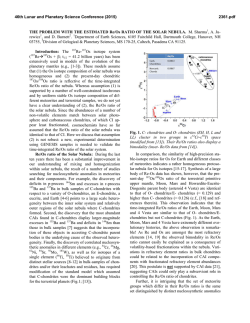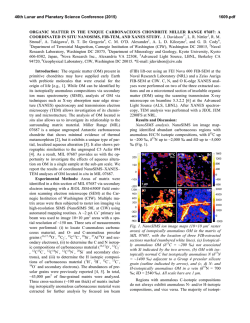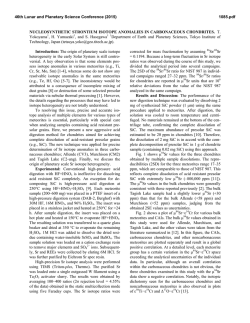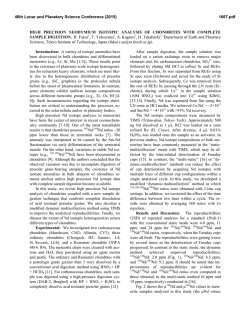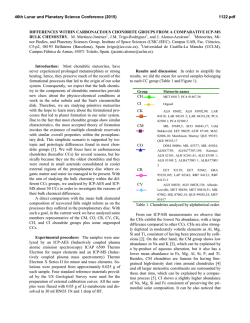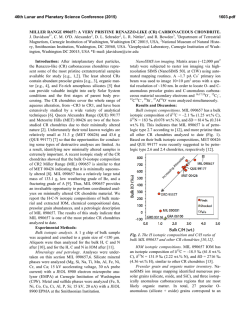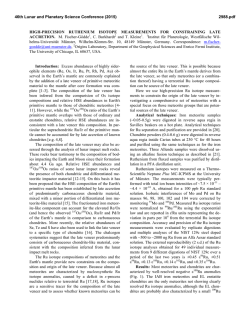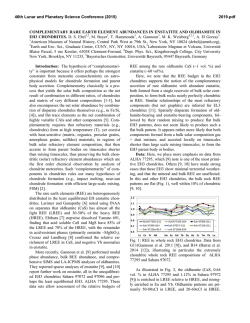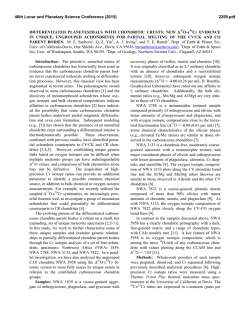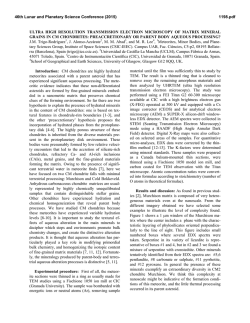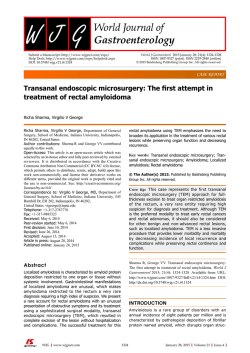
Evidence for Reduced Carbon-Rich Regions in the Solar Nebula
46th Lunar and Planetary Science Conference (2015) 2625.pdf EVIDENCE FOR REDUCED CARBON-RICH REGIONS IN THE SOLAR NEBULA FROM AN UNUSUAL COMETARY DUST PARTICLE. B. T. De Gregorio1, R. M. Stroud2, L. R. Nittler3, A. L. D. Kilcoyne4, 1Nova Research, Inc. (Alexandria, VA; [email protected]), 2Naval Research Laboratory (Code 6366, 4555 Overlook Ave. SW, Washington, DC 20375), 3Department of Terrestrial Magnetism, Carnegie Institution of Washington (5241 Broad Branch Rd. NW, Washington, DC 20015), 4Advanced Light Source, Lawrence Berkeley National Laboratory, Berkeley, CA. Introduction: Dust particles collected from Comet 81P/Wild 2 by NASA’s STARDUST spacecraft contains a wide variety of Fe-rich phases, ranging from metal grains to Fe-rich silicates (e.g., fayalite) [1]. This material encompases a large range of oxygen fugacity present in the solar nebula [2, 3], consistent with the current model of efficient outward transport of material from the inner solar nebula to the Kuiper Belt [4]. Small amounts of Fe-carbide have been observed in unequilibrated ordinary chondrites [5] and are a characteristic, but minor, component of the highly-reduced enstatite chondrites [2], but have not yet been observed in either IDPs or comet samples. This is not surprising as most carbides probably formed via carburization after accretion on the parent bodies [6]. Enstatite chondrites, on the other hand, are much more reduced, and their carbides may indeed be nebular condensates in regions where C/O 1 [2, 7]. Since comets were not heated, metal grains could not react with local carbonaceous matter to form carbides. Here we describe a cometary grain containing an unusual assemblage of Cr-rich magnetite, poorly graphitized carbon (PGC), and cohenite (Fe3C). We previously reported this assemblage last year [8], focusing on the highly aromatic nature of the PGC. Here we discuss the inorganic components and their likely formation within the solar nebula prior to accretion on Wild 2. Samples and Methods: A wafer of aerogel containing a cometary terminal particle from Track 183 (C2103,24,183,1,0) was dissected with a micromaniupulator, and the particle was embedded in S and ultramicrotomed. An unusual reddish color was visible during sample preparation [Figure 1a]. Sections designated for transmission electron microscopy (TEM) were placed on C-supported TEM grids, while alternating sections were placed on SiO-supported grids for scanning-transmission X-ray microscopy (STXM). Thicker sections were also prepared for secondary ion mass spectrometry (SIMS) and placed on Si3N4 window supports. Nanoscale morphology, mineralogy, and composition were characterized with a JEOL 2200FS TEM at NRL, while the organic functional chemistry of adjacent sections were characterized with the STXM instrument at beamline 5.3.2.2 at the Advanced Light Figure 1. (A) Optical view of the Track 183 terminal particle in sulfur after ultramicrotomy. (B) TEM image of a portion of the grain, showing three inclusions of carbonaceous material. Source. Isotopic analysis (C, N, and O) were performed with a Cameca NanoSIMS 50L at CIW. Results: The bulk of the particle is composed of elongated nanoparticles (average 15 nm × 30 nm) of an Fe-rich phase [Figure 2a], which also contains about 10 at.% Cr. Selected area electron diffraction (SAED) of this material reveals rings with spacings consistent with a spinel structure [9]. Although abundant Cr is present, the overall composition is closer to magnetite than chromite [(Fe2+0.91Ni0.09)(Fe3+1.70Cr0.30)O4]. Isotopic analysis of this material shows δ17O and δ18O values indistinguishable from terrestrial values within relatively large errors of ±100‰, ruling out a presolar, stellar origin. Carbonaceous Inclusions. Within the bulk Cr-rich magnetite are several 2-3 μm inclusions of a carbonaceous nanoparticulate material [Figure 1b, 2b]. SAED reveals diffraction rings consistent with poorly graphitized carbon (PGC), and XANES spectra are also consistent with PGC [8]. Isotopic analyses of the PGC show terrestrial δ13C and δ15N values, consistent with a nebular origin. In addition, 5-10 nm Fe-rich nanoparticles are present in the cores of the PGC particles [Figure 2c]. Fourier analysis of lattice fringes visible in several core Fe grains indicate a cohenite (Fe3C) crystal structure rather than that of Fe metal. Discussion: The nanoparticulate texture of the particle indicates that it is a primary nebular condensate and did not experience any significant heating during its residence on Wild 2 or during aerogel capture. The sequence of condensation is clearly: 46th Lunar and Planetary Science Conference (2015) 2625.pdf Fe-cores → PGC → Cr-rich magnetite Figure 2. (A) TEM image of nanoparticulate bulk material, with diffraction rings (inset) consistent with spinel. (B) TEM image of nanoparticulate carbonaceous inclusions, with diffraction rings (inset) consistent with poorly graphitized carbon (PGC). (C) High resolution TEM image of Fe-bearing core grains within the PGC. Visible lattice fringes (highlighted in color) are consistent with cohenite rather than Fe-metal. If the Fe-cores originally condensed in the nebula as cohenite, it would require a local gas composition of C/O > 1. This is generally not thought likely because (i) the components of the highly-reduced enstatite chondrites only require C/O = 0.95-0.98 [2] and (ii) Fe-carbides can be relatively easily produced on parent bodies by reaction between Fe-metal and carbonaceous matter [6]. However, C/O > 1 could be achieved either by locally adding interstellar carbonaceous dust or removing water. Since the PGC does not contain an interstellar isotopic composition, the cohenite must have condensed in a locally dry region of the nebula [7], consistent with the formation of enstatite chondrites [10]. Theoretical calculations of condensation from a nebular gas predict that PGC should condense last in the sequence [11]. This suggests that the PGC is a reaction product of surface-bound chemistry on the Fecores, possibly via a Fischer-Tropsch-type (FTT) reaction, rather than a condensate. If so, the cohenite cores could have initially condensed as metal grains, which were later converted to cohenite. This would also have occurred in a C-rich, relatively dry region in the solar nebula. Finally, the elongated shape of the Cr-rich magnetite suggests condensation within a strong magnetic field. Pure magnetite typically forms equant crystal forms, but will crystallize into nanorods or nanowires in the presence of a magnetic field [12]. This may require condensation within 0.1 AU, where magnetic fields within the disk exceed 10 mT [13]. References: [1] Zolensky M. E. et al (2006) Science, 314, 1735-1739. [2] Krot A. N. et al. (2006) In: Protostars and Planets IV, 1019-1054. [3] Ogliore R. C. et al. (2010) EPSL, 296, 278-286. [4] Brownlee D. E. et al. (2012) M&PS, 47, 453-470. [5] Krot A. N. et al. (1997) GCA, 61, 219-237. [6] Keller L. P. (1998) M&PS, 33, 913-919. [7] Taylor G. J. et al. (1981) LPSC XII, 1076-1078. [8] De Gregorio B. T. et al. (2014) LPSC XLV, Abstract #2759. [9] De Gregorio B. T. and Stroud R. M. (2013) 76th MetSoc, Abstract #5359. [10] Baedecker P. A. and Wasson J. T. (1975) GCA, 39, 735-765. [11] Ebel D. S. (2006) In: Meteorites and the Early Solar System II, 253-277. [12] Wang J. et al. (2004) Adv. Materials, 16, 137-140. [13] Stepinski T. F. et al. (1993) Icarus, 106, 77-91.
© Copyright 2025
